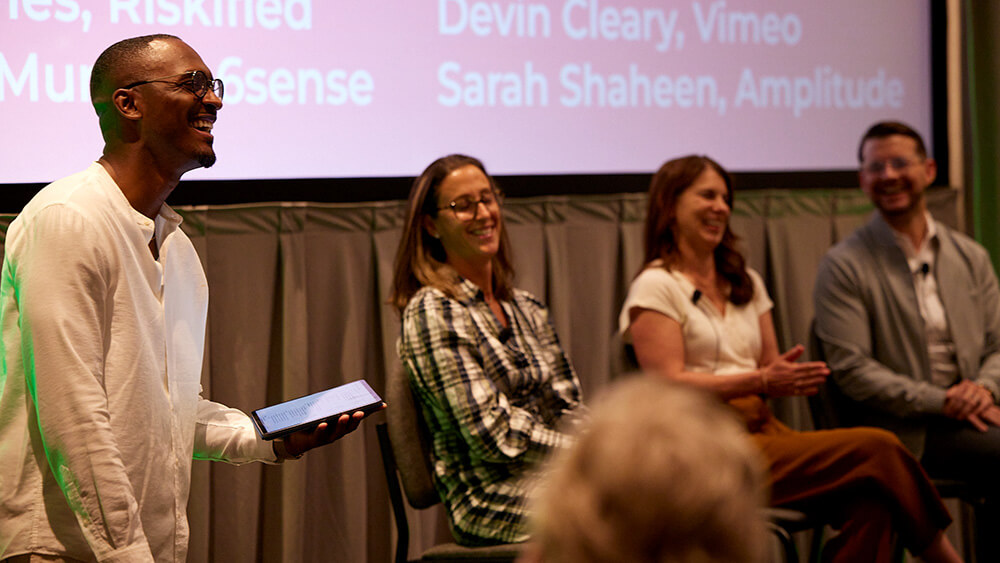
Tavar James (left), global head of field marketing and events at Riskified, moderates a panel at CEMA Summit 2023. (Two Dudes Photo)
More than 500 corporate event marketers and their industry partners came together for CEMA Summit 2023, powered by PCMA, Aug. 6-8 in Salt Lake City, Utah, for a program designed to help them sharpen their strategy, analytics, and soft skills.
For the September/October issue, Convene editors summarized main takeaways from a handful of sessions to give you a sample of the knowledge exchanged during those three days. We continue the series online with ideas to help organizers think like content strategists.
CEMA Summit Session: ‘Getting the Green Light: Secrets to Executive Buy-In on Your Event Strategy’
Build trust with executives through relationships and data that clearly demonstrates event impact — that was the overarching theme of the session moderated by Tavar James, global head of field marketing and events at Riskified. The speakers — Sarah Shaheen, director of corporate and strategic events at Amplitude; Devin Cleary, head of global events at Vimeo; and Bethany Murphy, senior director of events at 6sense — broke down their strategies for success, from building a convincing case to presenting a strategy to demonstrating impact. Below, five key takeaways from their conversation.
Get close with your C-suite. For Cleary, that starts with creating custom profiles for each executive, detailing everything from their communication preferences to their risk tolerance to the metrics they prioritize. James, Shaheen, and Murphy all emphasized that maintaining close relationships with executives’ chiefs of staff and/or assistants is also essential. Shaheen even goes as far as running presentations by them first — “they poke holes…,” she said. “They may know something I don’t know or am not privy to yet.”
Lean on data. We know data plays an important role when it’s time to demonstrate impact, post-event — but it’s also important at the start when building an event strategy. Murphy devotes time to developing appropriate metrics for each kind of event she produces, “so that you’re not setting yourself up for failure,” she said.
But what if the data doesn’t paint a rosy picture? Dig deeper. When Salesforce metrics didn’t tell her event’s full story, Shaheen worked closely with her sales team to find positive customer anecdotes instead. Or, change the metrics to better suit your goals. “ROI is very difficult to tie back to direct sales,” Cleary said. Instead, his team adopted a new term — ROO, return on objective — asking leadership to select two event objectives to aspire to. “By repositioning the conversation,” he said, “you’re going to make it easier for yourselves to paint the bigger picture, and not just fall to ROI which can distort the true value of what that event is driving for you.”
Think like a politician. “There are a lot of similarities between us, event marketers, and politicians,” Cleary said. “It’s our job to be the vocal representation of our team.” Early on in his career, Cleary adopted this mindset, applying the components of a political campaign to event strategy — everything from researching your audience to understanding the competitive landscape to building a pitch.
Go in with an opinion. Walking into meetings with leadership with confidence, with a clear point of view and specific recommendations, is “what sets you apart from being an event manager and an event leader,” Shaheen said. James agrees: “I think as events people we’re typically on the reactive side. You all have a voice … you’re the subject matter experts in this space.”
Prioritize consistent communication. Take the lead on sending updates to leadership early on. That can include changes in impact reports from past events as well as weekly updates on upcoming events. “We don’t want them to forget about the event the day it ends,” Murphy said. She likes to show how the event has impacted business 30, 60, and 90 days out, which also helps steer strategy for future events. Cleary takes it a step further, highlighting new ideas or industry trends they’re adopting to show that his team is thinking strategically, not just tactically. “Executives want to feel cutting edge and on the top of their game,” he said. “As even.t leaders, [start to think about] how can you start to tease out new ideas to get them excited.”
Jennifer N. Dienst is senior editor at Convene.
More From CEMA Summit
- Do You Need a KPI Event Playbook?
- Leading Your Team With Compassion and Transparency
- How to Think Like an Event Content Strategist
